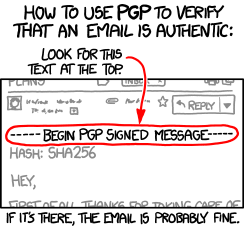PGP

If you want to be extra safe, check that there's a big block of jumbled characters at the bottom.

If you want to be extra safe, check that there's a big block of jumbled characters at the bottom.
PGP (Pretty Good Privacy) is a program which can be used to encrypt and/or sign data, including messages sent as emails. Encrypting means encoding data in a way that requires a secret key to decrypt and read; signing means that there is a code included in the data which can be used to verify the identity of the sender and that the data has not been altered in transit.
In the case of the email in this comic, it has only been signed; not encrypted (hence, the top of the first line of text can be seen and is legible in normal English). This is more common than encryption, as reading an encrypted message would require the recipient to already be a PGP user. In fact, the use of PGP even to sign email messages is so rare that most people have probably never seen a signed message. Because a signed email is so rare, and because it is already legible and unencrypted, Randall is making the tongue-in-cheek observation that few users, technical or otherwise, actually know how to use the signature to verify the authenticity of the sender using the PGP signature, and that such users can safely assume that since there is a signature, that is good enough evidence that the message is authentic. Further, because PGP signatures are so rare and probably ignored by most recipients, he suggests one would not expect anyone to even bother creating a false PGP signature; therefore the mere existence of a PGP header would suggest authenticity.
The title text extends the joke by suggesting you confirm there's a bunch of random characters in the footer (this is the actual signature that PGP generates which can be used to verify the authenticity of the email). Again, Randall is humorously suggesting that the existence of the block is itself sure evidence of authenticity.